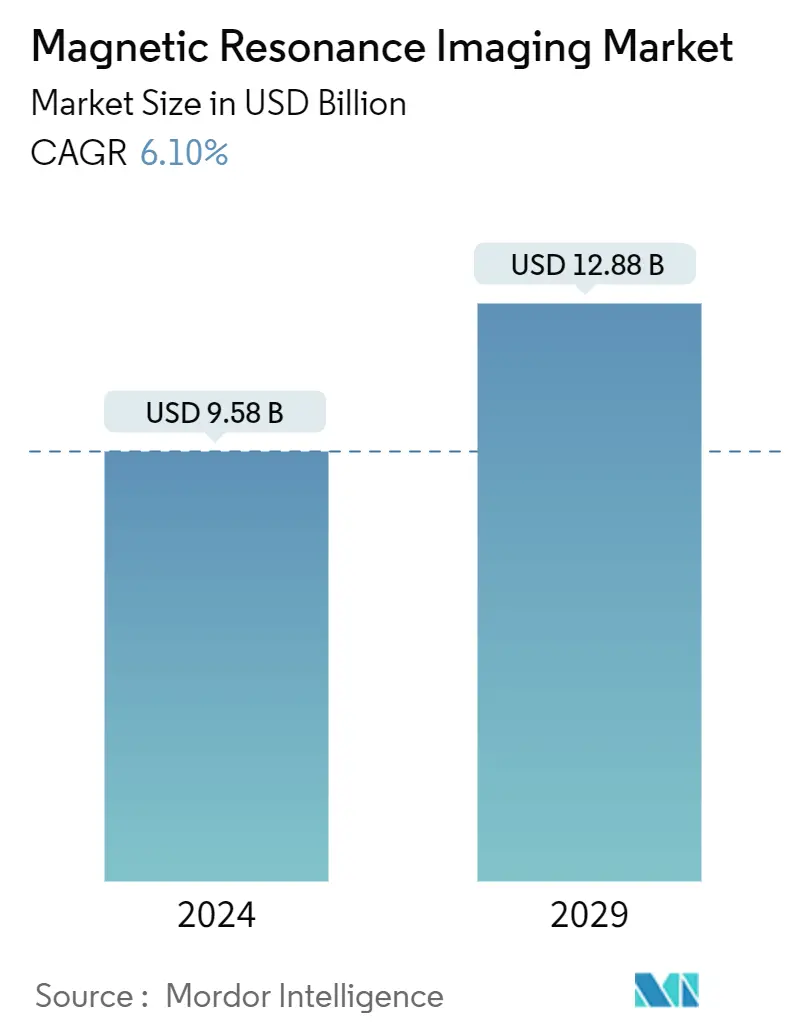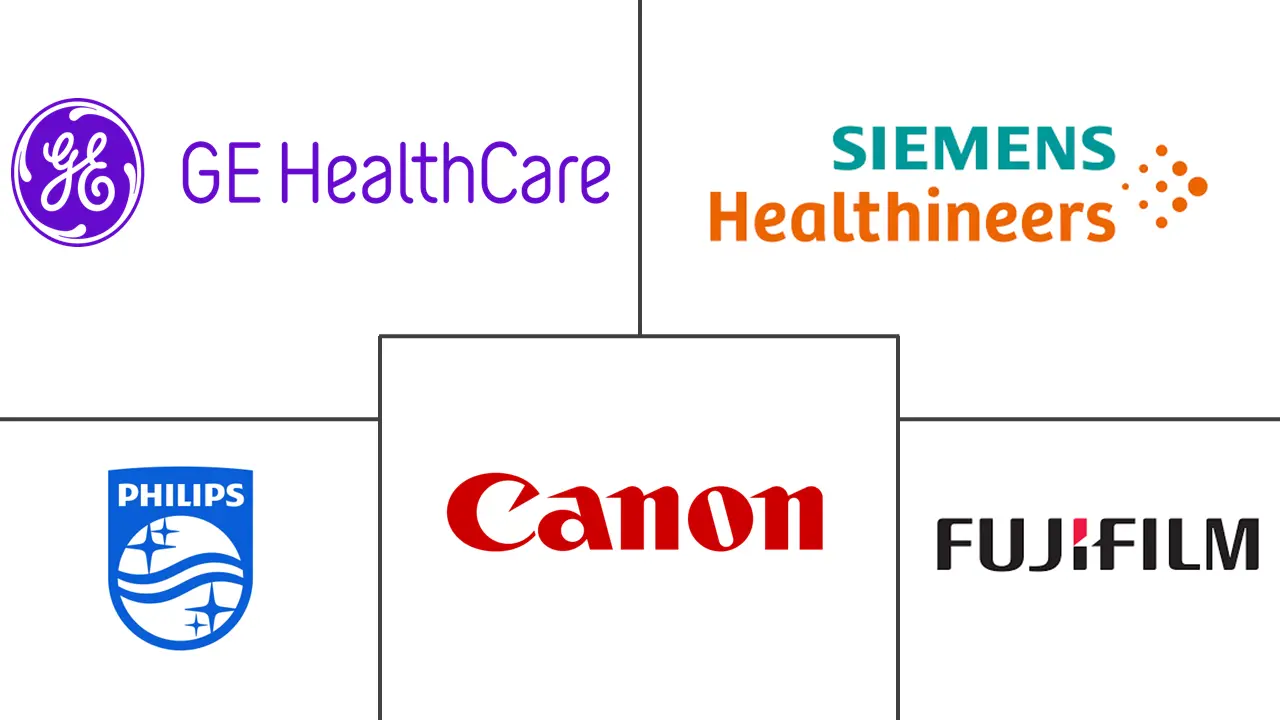Market Size of Magnetic Resonance Imaging Industry

| Study Period | 2019 - 2029 |
| Market Size (2024) | USD 9.58 Billion |
| Market Size (2029) | USD 12.88 Billion |
| CAGR (2024 - 2029) | 6.10 % |
| Fastest Growing Market | Asia Pacific |
| Largest Market | North America |
| Market Concentration | Medium |
Major Players
*Disclaimer: Major Players sorted in no particular order |
Magnetic Resonance Imaging Market Analysis
The Magnetic Resonance Imaging Market size is estimated at USD 9.58 billion in 2024, and is expected to reach USD 12.88 billion by 2029, growing at a CAGR of 6.10% during the forecast period (2024-2029).
Factors such as the development of hybrid MRI systems, the presence of universal health coverage in regions like North America, Europe, and parts of Asia, and increased usage in emerging markets due to rising disease rates are driving expansion in the MRI industry. For instance, in March 2023, Children's Minnesota became one of the first North American health systems to launch a pediatric hybrid intraoperative MRI suite with both moving-scanner and moving-patient MRI technology in the same surgical space.
The use of multimodality imaging, especially with integrated PET/CT and commercialized PET/MRI systems, is becoming increasingly important within the Medical Imaging market. This trend is anticipated to contribute significantly to market growth. For instance, a study published by the Journal of Nuclear Medicine in December 2023 highlighted how hybrid PET/MRI can offer a more thorough understanding of brain pathology linked to cognitive decline, aiding in Alzheimer's disease diagnosis. Such research underscores the potential of hybrid imaging systems to enhance diagnostics and drive expansion in the Diagnostic Imaging market.
One major factor driving growth in the MRI Systems market during the forecast period is the widespread availability of universal health coverage in many countries worldwide. This coverage reduces the financial burden on individuals for medical procedures like MRI scans, encouraging regular testing and treatment. For instance, 80%-90% of citizens in the United States are covered by programs like Medicare, Medicaid, and SCHIP, while in Canada, Medicare provides health insurance.
Additionally, the adoption and advancement of MRI technology in emerging markets are increasing through the establishment of new facilities across different countries. For instance, in August 2023, India launched one of the first domestically developed, lightweight, high-field (1.5 Tesla), affordable, ultrafast MRI scanners in New Delhi. Under the National Biopharma Mission, this initiative addresses the country's healthcare needs. The development of MRI tailored to the emerging markets' requirements is likely to boost the adoption of the technology and enhance overall market growth.
Thus, owing to the abovementioned factors, such as increasing advancements in MRI and insurance coverage, the market is expected to project significant growth during the forecast period. However, due to the high cost of the MRI systems and associated procedures coupled with the decreasing availability of helium, the growth of the MRI market is expected to be hampered.
Magnetic Resonance Imaging Industry Segmentation
As per the scope of the report, magnetic resonance imaging is a medical imaging technique used in radiology to produce pictures of the anatomy and the body's physiological processes. These pictures are further used to diagnose and detect the presence of abnormalities in the body.
The magnetic resonance imaging market is segmented by architecture, field strength, application, and geography. By architecture, the market is segmented into closed MRI systems and open MRI systems. The market is segmented by field strength into low-field MRI systems, high-field MRI systems, very high-field MRI systems, and ultra-high MRI systems. By application, the market is segmented into oncology, neurology, cardiology, gastroenterology, musculoskeletal, and other applications. The market is segmented by geography into North America, Europe, Asia-Pacific, the Middle East and Africa, and South America. The report also covers the estimated market sizes and trends for 17 countries across major regions globally. The report offers the value in USD for the above segments.
| By Architecture | |
| Closed MRI Systems | |
| Open MRI Systems |
| By Field Strength | |
| Low Field MRI Systems | |
| High Field MRI Systems | |
| Very High Field MRI Systems and Ultra-high MRI Systems |
| By Application | |
| Oncology | |
| Neurology | |
| Cardiology | |
| Gastroenterology | |
| Musculoskeletal | |
| Other Applications |
| Geography | ||||||||
| ||||||||
| ||||||||
| ||||||||
| ||||||||
|
Magnetic Resonance Imaging Market Size Summary
The magnetic resonance imaging (MRI) market is poised for significant growth over the forecast period, driven by advancements in technology and increased demand for diagnostic imaging. The development of hybrid MRI systems and the integration of multimodality imaging, such as PET/CT and PET/MRI systems, are key factors propelling market expansion. These innovations enhance diagnostic capabilities, particularly in areas like Alzheimer's disease and cancer detection, where MRI plays a crucial role. The widespread availability of universal health coverage in regions like North America, Europe, and parts of Asia further supports market growth by reducing the financial burden on patients and encouraging regular medical testing. Additionally, the adoption of MRI technology in emerging markets, supported by initiatives like India's domestically developed MRI scanners, is expected to boost market penetration and growth.
North America remains a dominant force in the MRI market, supported by a robust healthcare system and a high prevalence of chronic diseases necessitating advanced imaging solutions. The region's market growth is further fueled by ongoing product development and the adoption of new MRI systems by healthcare providers. Major players like Siemens Healthineers, GE Healthcare, Canon Medical Systems, and Philips Healthcare hold significant market shares, while mid-size companies are expanding their presence through innovative and cost-effective solutions. The market's semi-consolidated nature allows for competitive dynamics, with companies like Ezra leveraging artificial intelligence to enhance MRI imaging and early cancer detection. Collaborative efforts, such as Philips' partnership with Polarsan, aim to improve MRI technology for specific medical conditions, highlighting the continuous evolution and potential of the MRI market.
Magnetic Resonance Imaging Market Size - Table of Contents
-
1. MARKET DYNAMICS
-
1.1 Market Overview
-
1.2 Market Drivers
-
1.2.1 Introduction of Hybrid MRI Systems
-
1.2.2 Availability of Universal Health Coverage in North America, Europe, and Several Asian Countries
-
1.2.3 Increasing Adoption in Emerging Markets
-
-
1.3 Market Restraints
-
1.3.1 High Cost of MRI Systems
-
1.3.2 Declining Helium Availability
-
-
1.4 Porter's Five Forces Analysis
-
1.4.1 Threat of New Entrants
-
1.4.2 Bargaining Power of Buyers/Consumers
-
1.4.3 Bargaining Power of Suppliers
-
1.4.4 Threat of Substitute Products
-
1.4.5 Intensity of Competitive Rivalry
-
-
-
2. MARKET SEGMENTATION (Market Size by Value - USD)
-
2.1 By Architecture
-
2.1.1 Closed MRI Systems
-
2.1.2 Open MRI Systems
-
-
2.2 By Field Strength
-
2.2.1 Low Field MRI Systems
-
2.2.2 High Field MRI Systems
-
2.2.3 Very High Field MRI Systems and Ultra-high MRI Systems
-
-
2.3 By Application
-
2.3.1 Oncology
-
2.3.2 Neurology
-
2.3.3 Cardiology
-
2.3.4 Gastroenterology
-
2.3.5 Musculoskeletal
-
2.3.6 Other Applications
-
-
2.4 Geography
-
2.4.1 North America
-
2.4.1.1 United States
-
2.4.1.2 Canada
-
2.4.1.3 Mexico
-
-
2.4.2 Europe
-
2.4.2.1 Germany
-
2.4.2.2 United Kingdom
-
2.4.2.3 France
-
2.4.2.4 Italy
-
2.4.2.5 Spain
-
2.4.2.6 Rest of Europe
-
-
2.4.3 Asia-Pacific
-
2.4.3.1 China
-
2.4.3.2 Japan
-
2.4.3.3 India
-
2.4.3.4 Australia
-
2.4.3.5 South Korea
-
2.4.3.6 Rest of Asia-Pacific
-
-
2.4.4 Middle East and Africa
-
2.4.4.1 GCC
-
2.4.4.2 South Africa
-
2.4.4.3 Rest of Middle East and Africa
-
-
2.4.5 South America
-
2.4.5.1 Brazil
-
2.4.5.2 Argentina
-
2.4.5.3 Rest of South America
-
-
-
Magnetic Resonance Imaging Market Size FAQs
How big is the Magnetic Resonance Imaging Market?
The Magnetic Resonance Imaging Market size is expected to reach USD 10.16 billion in 2025 and grow at a CAGR of 6.10% to reach USD 13.67 billion by 2030.
What is the current Magnetic Resonance Imaging Market size?
In 2025, the Magnetic Resonance Imaging Market size is expected to reach USD 10.16 billion.

